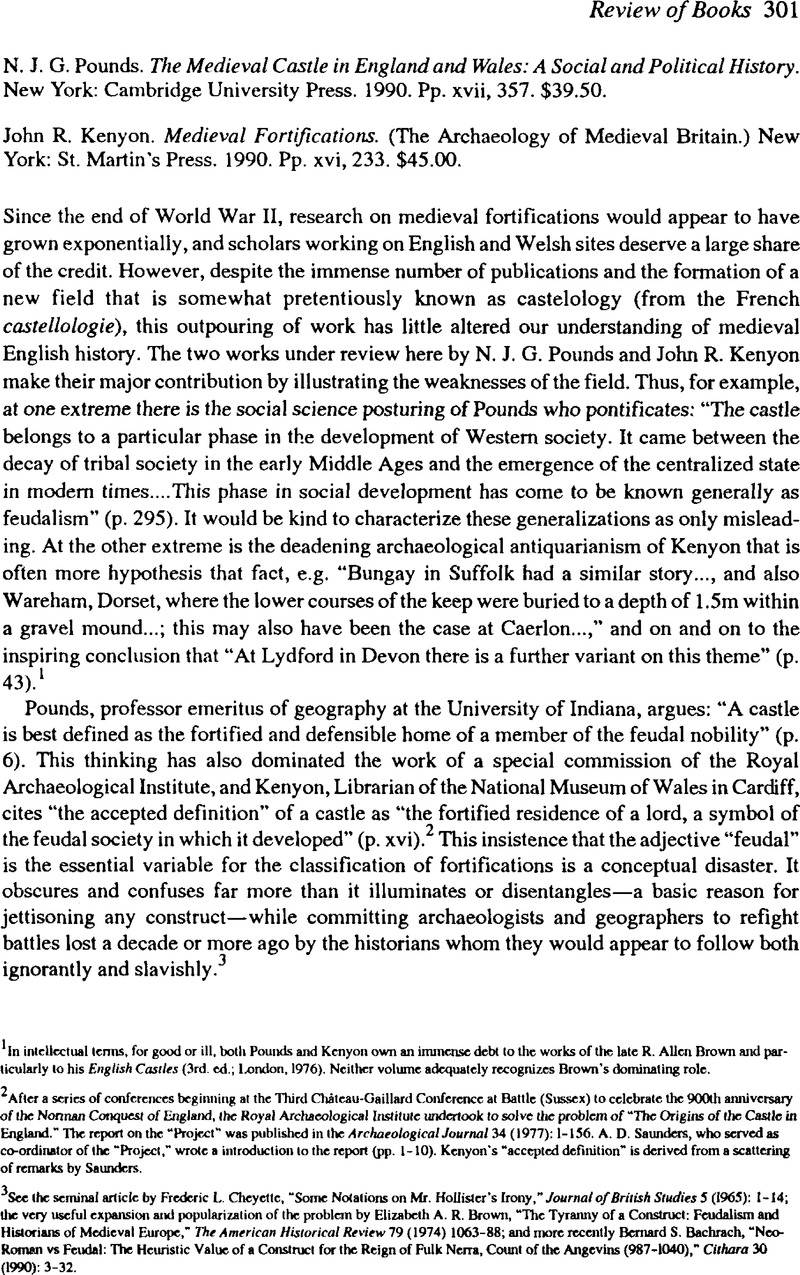No CrossRef data available.
Published online by Cambridge University Press: 11 July 2014

1 In intellectual terms, for good or ill, both Pounds and Kenyon own an immense debt to the works of the late Brown, R. Allen and particularly to his English Castles (3rd. ed.; London, 1976)Google Scholar. Neither volume adequately recognizes Brown's dominating role.
2 After a series of conferences beginning at the Third Chateau-Gaillard Conference at Battle (Sussex) to celebrate the 900th anniversary of the Norman Conquest of England, the Royal Archaeological Institute undertook to solve the problem of “The Origins of the Castle in England.” The report on the “Project” was published in the Archaeological Journal 34 (1977): 1–156Google Scholar. A. D. Saunders, who served as co-ordinator of (he “Project,” wrote a introduction to the report (pp. 1-10). Kenyon's “accepted definition” is derived from a scattering of remarks by Saunders.
3 See the seminal article by Cheycttc, Frederic L., “Some Notations on Mr. Hollisler's Irony,” Journal of British Studies 5 (1965): 1–14Google Scholar; the very useful expansion and popularization of the problem by Brown, Elizabeth A. R., “The Tyranny of a Construct: Feudalism and Historians of Medieval Europe,” The American Historical Review 79 (1974) 1063–88CrossRefGoogle Scholar; and more recently Bachrach, Bernard S., “Neo-Roman vs Feudal: The Heuristic Value of a Construct for the Reign of Fulk Nerra, Count of the Angevins (987-1040),” Cithara 30 (1990): 3–32Google Scholar.
4 Bachrach, Bernard S., “Some Observations on the Military Administration of the Norman Conquest,” in Anglo Norman Studies, ed. Brown, R. Allen (Woodbridge, 1986), pp. 1–25Google Scholar; “Some Observations on the Bayeux Tapestry,” Cithara 27 (1987): 5–28Google Scholar; and “Angevin Campaign Forces in the Reign of Fulk Nerra, Count of the Angevins (987-1040),” Francia 16, 1 (1989): 67–84Google Scholar. Cf. Pounds, pp. 3-4, where the military demography of the Norman conquest is off by almost 200%, and p. 7 where the fortifications at Pevensey and Hastings are misconstrued. It is well known, for example, on the basis of archaeological evidence that the molle at Hastings “bore no relation to the picture of the mound of Hastings Castle in the Bayeux Tapestry” (Saunders, “Project,” p. 6).
5 Bachrach, Bernard S., “Fortifications and Military Tactics,” Technology and Culture 20 (1979): 531–49CrossRefGoogle Scholar; “The Angevin Strategy of Castle-Building in the Reign of Fulk Nerra, 987-1040.” The American Historical Review 88 (1983): 533–60CrossRefGoogle Scholar; and “caballus et caballarius in Medieval Warfare,” in The Story of Chivalry, ed. Chickering, H. and Seiler, T. (Kalamazoo, Mich., 1988), pp. 173–211Google Scholar.
6 Abels, Richard, Lordship and Military Obligation in Anglo-Saxon England (Berkeley, 1988), pp. 74–75Google Scholar; and Bachrach, Bernard S. and Aris, Rutherford, “Military Technology and Garrison Organization: Some Observations on Anglo-Saxon Military Thinking in Light of the Burghal Hidage,” Technology and Culture 31 (1990): 1–17CrossRefGoogle Scholar.
7 Bachrach, Bernard S., “Animals and Warfare in Early Medieval Europe,” Settimane di studio delcentro di studi suli' alto medioevo 31 (Spolelo, 1985), 1: 707–64Google Scholar.
8 See, for example, Bachrach, Bernard S., “The Cost of Castle-Building: The Case of the Tower at Langeais, 992-994,” in The Medieval Castle: Romance and Reality, ed. Reyerson, K. and Powe, F. (Dubuque, Ia., 1984), pp. 46–62Google Scholar (four plates), with the literature cited there.
9 Bachrach, Bernard S., “Rarly Medieval Fortifications in the ‘West’ of France: A Revised Teclmical Vocabulary,” and “Fortifications and Military Tactics,” Technology and Culture 16 (1975): 531–69CrossRefGoogle Scholar and 20 (1979): 531-49.